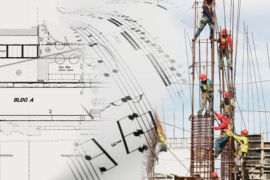I stopped wearing a mask to work. I stopped wondering if I should have a doctor swab my nasal passages every time I sneezed—just in case—and laws imposing restrictions on movement and interaction have largely been repealed. Whatever your opinion on these measures, it is likely we will never return to pre-pandemic normalcy, a fact echoed recently in an odd corner of my work here at PEG, namely in the increasing number of quality contractors demanding Cost-Plus construction contracts throughout the United States.
For those who are unfamiliar with Cost-Plus contracts, a simple definition would look something like the following:
a contract for construction where the party agreeing to complete construction of a project (the “Contractor”) will be reimbursed for the cost of the work under that agreement and whose compensation will equal some percentage of that reimbursable cost (the “Fee”).
As you can likely see from that definition, a Cost-Plus contract not only favors the contractor because of the blanket reimbursement right, but such a contract also incentivizes the contractor to ignore or even effect increases in construction costs. Historically, owners and developers, including PEG, would refuse to enter a Cost-Plus contract because of the risks associated with it, thus placing the risk of changes in material costs and manpower shortages on the Contractor. The intent of this was to place the risks associated with such changes on the contracting party with the greatest ability to manage that risk.
But COVID…
In the face of rising shipment risk, ongoing production delays, pervasive manpower shortages, and so many other changes to the real estate development process, we have seen quality contractors throughout the United States unwilling to enter into more traditional construction relationships. Such demands require ownership to adapt, especially in crowded construction markets, and create a plan for protecting themselves in the event a Cost-Plus construction contract is the best option available.
Here are six practice tips that can help an owner protect themselves from the risk posed by a Cost-Plus contract:
1) Demand Quantity Guarantees. No matter what happens with pricing and delays, the Contractor should be able to review the project plans and specifications and ascertain the correct quantity of all materials demanded by the job. The Contractor is the expert here—or at least hires the expert—and will likely be the sole party to the Cost-Plus contract who reviews the construction documents in detail. In the event the Contractor misses a call-out for light fixtures or doesn’t order enough floorboards, costs associated with such fixes should not be borne by ownership.
2) Limit Increases in the Contractor’s Fee. Money talks—and practically screams—when dealing with a Contractor. Ownership can limit the number of circumstances in which the Fee will be increased, perhaps fixing the Fee upon execution of the construction contract and, thereafter, prohibiting Fee increases from the Contractor’s failure to achieve an intermediate schedule milestone or because of the increase in the cost of a particular material.
3) Eliminate Budgetary Fluff. Traditionally, construction contracts will include some budgetary fluff—called contingency, allowances, and alternates—designed to protect the Contractor against unforeseen circumstances. Owners accustomed to allowing Contractors such permission should be aware that under a Cost-Plus contract, the only party who needs to pad their budget to avoid cost overruns is ownership. A careful review of the subcontracts and other documentation supporting the anticipated budget provided by the Contractor should eliminate these amounts. In the event a Contractor pushes back against your removal, remind the Contractor that the Fee will increase in the face of valid changes.
4) Carefully Select the Project Team. A Cost-Plus contract can be seen by some Contractors as a blank check, it is critical to carefully select not just the Contractor but the Contractor’s employees brought to the jobsite. These should be sophisticated, trustworthy, and collaborative individuals from the Contractor’s “A-Team”. This is every owner’s dream, right? It should be a reality on any Cost-Plus contract, though.
5) Demand Transparency. Because each cost incurred in the construction of the work flows through to ownership, strict transparency should be secured under the contract and exercised early and often during construction. Every subcontract should be subject to review. Every invoice provided by the Contractor should be audited and verified. While this is cumbersome, this oversight is the sole mechanism ownership will have against unnecessary cost-overruns or price-fixing.
6) Reduced Risk means a Reduced Fee. The first five tips may seem to force ownership to act more like a construction manager. This is intentional. Cost-Plus contracts remove risk from the Contractor and place it on ownership. As the Contractor is less exposed under this contract relationship, the Contractor should not be surprised when required to lower the percent Fee in conjunction with their lowered exposure. Simply, a Cost-Plus contract should be cheaper to ownership because ownership is doing more and more exposed.
While the prevalence of Cost-Plus contracts as an industry standard has yet to be determined—this article is not meant as a harbinger of that future—I hope the above allow owners confronted by the recent resurgence of this contract type to better manage the potential risks associated with such agreements.
As with all PEG posts, feel free to reach out to our team should you be interested in addressing this matter in greater detail.
















